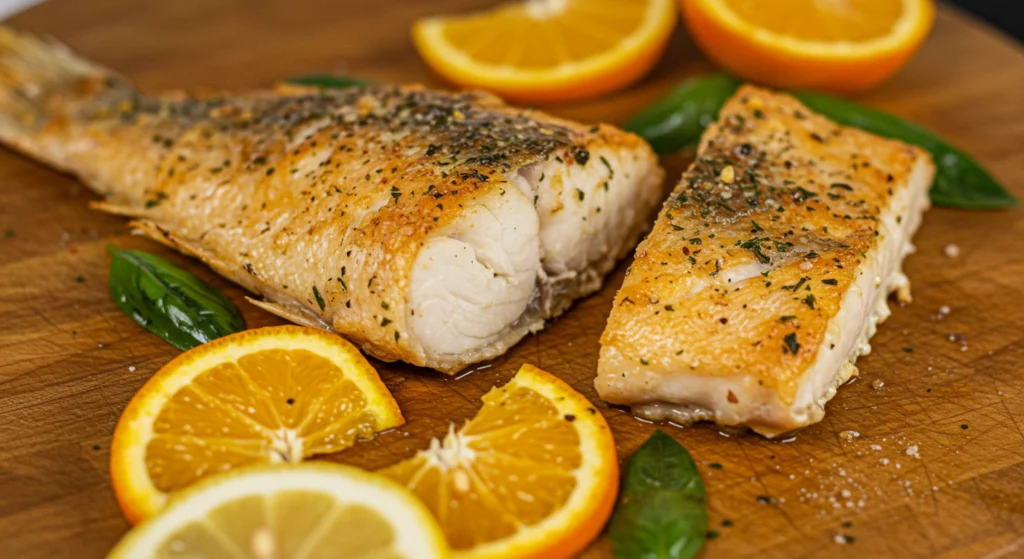Delicious Baked Orange Roughy Recipe
Table of Contents
Discover the simplicity of the baked orange roughy recipe, a seafood recipe perfect for any occasion. This flaky white fish offers a mild, delicate flavor that shines when baked. It’s ideal for a quick fish dinner or a sophisticated meal. Whether you’re a cooking novice or a seasoned chef, this versatile dish adapts easily to your taste with herbs, citrus, or spices.
This article guides you through choosing fresh fish, mastering baking techniques, and pairing your creation with complementary sides. Learn how to balance nutrition and flavor, ensuring every bite feels both satisfying and healthy. Perfect for weeknights or special events, this recipe combines ease with elegance.
Key Takeaways
- Baked orange roughy offers a mild taste that suits various seasonings.
- It’s a quick, low-maintenance fish dinner for busy schedules.
- Adaptable to both casual and elegant dining settings.
- Rich in protein and low in fat, making it a nutritious seafood choice.
- Easy to pair with sides like vegetables or rice for a complete meal.
What Is Orange Roughy and Why It’s Perfect for Baking
Orange roughy fish is a mild-flavored white fish. It has a firm texture, making it great for baking. Its neutral taste lets seasonings and marinades take center stage. Plus, its sturdy flesh stays moist in the oven.
The Unique Qualities of Orange Roughy Fish
This deep-sea fish is known for its lean, flaky yet resilient meat. When baked, its natural oils keep it moist. Its subtle sweetness pairs well with herbs like dill or lemon, making it versatile in recipes.
Sustainable Fishing Considerations
Orange roughy populations have faced overfishing. Choose sustainable seafood by looking for labels like the Marine Stewardship Council (MSC) certification.
“Sustainable practices ensure fish stocks recover while protecting ocean ecosystems,” states NOAA Fisheries.
Opt for wild-caught options with clear traceability to support eco-conscious fisheries.
How to Select Fresh Orange Roughy
When buying, look for these signs of freshness:
- Clear, unclouded eyes
- Bright red gills (not brown or gray)
- Firm flesh that springs back when touched
- No strong “fishy” odor—fresh fish should smell like the ocean
For visual clarity, here’s a quick guide:
| Characteristic | Sign of Freshness |
|---|---|
| Eyes | Clear and slightly bulging |
| Gills | Deep red (not grayish) |
| Flesh | Springy, not mushy |
Essential Ingredients for the Perfect Baked Orange Roughy Recipe
Choosing the right recipe ingredients makes your baked orange roughy stand out. Start with fresh or high-quality fillets. Look for firm, translucent flesh and a mild scent. Frozen fillets are okay if thawed right.
For orange roughy seasoning, a mix of herbs and spices boosts its taste. Here are some key ones:
- Dill and parsley: Add freshness and brightness
- Paprika and garlic powder: Provide warmth without overpowering
- Garlic and shallots: Create depth in flavor
A lemon butter sauce takes the dish to the next level. Here’s what you need:
| Ingredient | Role |
|---|---|
| Unsalted butter | Rich base for the sauce |
| Lemon juice | Sharpness to balance richness |
| Chopped herbs | Final aromatic touch |
Optional ingredients like capers or cherry tomatoes add texture. You can swap sparkling water for broth if you like. Adjust the seasonings to your taste. This recipe can fit what you have in your pantry. Fresh lemon wedges and parsley make a simple garnish for presentation.

Step-by-Step Guide to Preparing Your Baked Orange Roughy
Learning how to bake orange roughy requires careful preparation. Here’s how to make a dish that tastes like it came from a restaurant:
Preparing the Fish
First, make sure your fish is ready for the oven. If it’s frozen, thaw it in the fridge overnight. Dry the fillets with paper towels to help them get crispy.
Remove any excess skin or membranes. Use your hands or tweezers to check for pin bones. This step is key to even cooking and tender fish.
Creating Marinades and Seasonings
- For a quick marinade, mix olive oil, lemon juice, garlic, and herbs like dill or parsley. Let the fillets marinate for 15–20 minutes at room temperature.
- Try dry rubs: Mix paprika, salt, black pepper, and a pinch of cayenne. Rub the spices onto the fish’s surface before baking.
- Don’t over-marinate. The fish absorbs flavors quickly. Too much time can make it tough.
Baking Techniques and Temperatures
Choose your baking method:
- Sheet Pan: Put the fillets on a greased pan. Bake at 375°F (190°C) for 12–15 minutes per inch of thickness.
- En Papillote: Wrap the fillets in parchment with herbs and lemon slices. Bake at 400°F (200°C) for 10–12 minutes.
How to Tell When Your Fish Is Perfectly Cooked
Look for these signs:
- Visual cue: The flesh turns opaque and lightens in color.
- Texture test: It should flake easily with a fork but still hold its shape.
- Temperature: Use a thermometer to check the thickest part. It should read 145°F (63°C).
Follow these fish baking tips to avoid overcooking. Fish that’s not cooked enough is still translucent. Fish that’s overcooked is dry. Adjust the cooking time based on the size of the fillets.

Delicious Serving Suggestions and Pairings
Make your baked orange roughy even better with great pairings. These suggestions will boost both taste and looks. They’re perfect for impressing guests or making any meal more enjoyable.
Side Dishes That Complement Orange Roughy
Here are some orange roughy side dishes to match its mild flavor:
- Vegetables: Roasted asparagus, sautéed spinach, or grilled zucchini
- Starches: Lemon herb rice, garlic mashed potatoes, or quinoa pilaf
- Salads: Citrus vinaigrette greens or a light caprese salad
Garnishing Ideas for Presentation
Enhance your meal with these seafood dinner ideas tips:
- Drizzle with a light butter sauce or hollandaise for richness.
- Arrange microgreens or edible flowers around the plate for color.
- Serve lemon wedges and a sprinkle of fresh dill on the side.
These small changes can make any meal feel special, without much extra work.
Health Benefits and Nutritional Information of Orange Roughy
Orange roughy is a lean protein source that’s great for balanced diets. A 3.5-ounce serving has about 20g of seafood protein and very little fat. This makes it perfect for those watching their calories or macros. Its mild taste hides a wealth of nutrients that are good for your heart and bones.
| Nutrient | Per 3.5oz Serving |
|---|---|
| Calories | 90 |
| Protein | 20g |
| Total Fat | 1g |
| Vitamin D | 15% DV |
| Selenium | 40% DV |
| B12 & B6 | 10% DV each |

Beyond basic nutrients, orange roughy offers many health benefits:
- Vitamin D for bone strength
- Selenium to boost antioxidant activity
- B vitamins supporting energy metabolism
While it has less omega-3s than salmon or mackerel, it’s safer to eat often. Experts suggest eating 2-3 servings a week. Baking is better than frying because it keeps more nutrients and doesn’t add extra oils.
Choosing orange roughy over fish with more mercury is a smart move. It’s a sustainable seafood protein that fits your diet goals. Its mild taste also lets you add different seasonings without overpowering them.
Conclusion: Mastering the Art of Baked Orange Roughy
Baked orange roughy recipes are a simple way to make a tasty, protein-rich meal. This fish is mild in taste and firm in texture, making it perfect for beginners. By following the steps, you can get results that taste like they came from a restaurant.
Seafood cooking tips from this guide help you succeed every time. You can choose from lemon-herb flavors or creamy sauces. Orange roughy is also healthy, with low fat and lots of omega-3s, great for any meal.
Are you ready to try it? Get your ingredients and follow the steps to enjoy a dish that impresses. Share your ideas or ask questions. Baking orange roughy is more than cooking; it’s a way to try sustainable, affordable seafood that everyone will love.
FAQ
What makes orange roughy a good choice for baking?
Orange roughy is firm and flaky, with a mild, sweet taste. It keeps its shape well and soaks up flavors during baking. This makes it a favorite among home cooks.
How can I ensure that my orange roughy is sustainably caught?
Look for the Marine Stewardship Council (MSC) label or ask your fishmonger. Choosing wild-caught from managed fisheries supports sustainable fishing.
Are there specific signs I should look for when buying fresh orange roughy?
Yes! Fresh orange roughy should have clear, bright eyes and red gills. It should be firm, moist, and not smell fishy. These signs mean you’re getting a high-quality fish.
What are the best seasonings to use for orange roughy?
Use herbs like dill, parsley, and thyme, and spices like paprika and garlic powder. Add fresh garlic and shallots for flavor. Lemon juice and sparkling water add moisture and acidity.
What is the ideal oven temperature for baking orange roughy?
Bake orange roughy at 375°F to 400°F, depending on its thickness. This temperature helps it cook evenly and stay moist.
How can I tell when my orange roughy is fully cooked?
It’s done when it’s opaque and flakes easily with a fork. The internal temperature should be 145°F for safety.
What side dishes pair well with baked orange roughy?
Try roasted vegetables like asparagus, lemon herb rice, and light citrus salads. These dishes complement the fish’s delicate taste.
What are some garnishing ideas to enhance the presentation of baked orange roughy?
Use fresh microgreens, edible flowers, lemon wedges, or herb oils. They add color and flavor, making the dish look and taste better.
Is orange roughy healthy to eat, and what are its nutritional benefits?
Yes, it’s healthy because it’s low in fat and high in protein. It has about 20g of protein per 3.5oz serving. It’s also rich in selenium and vitamin D, making it good for many diets.
Are there any health concerns related to eating orange roughy?
Orange roughy is nutritious but may have mercury. It’s best to eat it in moderation, avoiding it for young children and pregnant women due to mercury risks.

